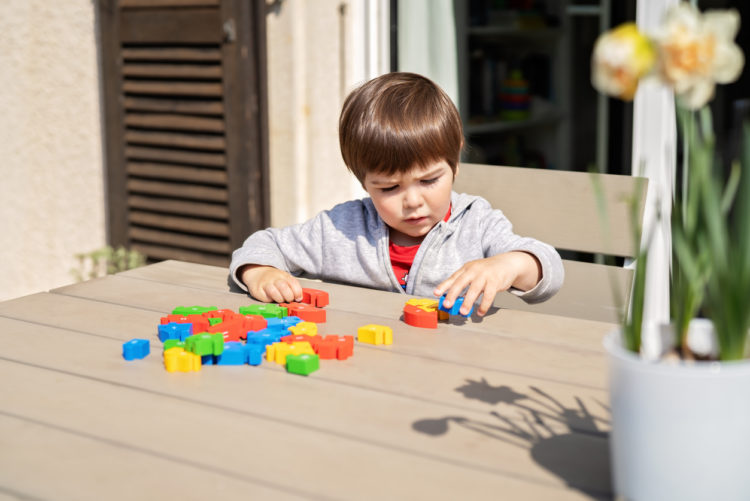At Home With Young Children? Build Preschoolers’ Speech and Language Skills With Everyday Interactions and Activities
As families around the country shelter in place, parents of preschoolers can help build their child’s speech and language skills during everyday activities at home.
Strong speech and language skills are key to kindergarten readiness and a precursor for reading, writing, and social success. Below are some key communication skills for children ages 3–5, and suggestions for how parents can help their preschoolers:
1. Following Directions
Teach or reinforce ways to follow directions throughout the day. Get your child’s attention, make sure they are looking at you, and go over the steps you take when getting dressed, washing hands, brushing teeth, or cleaning up toys. You can even create a picture or sign with the list of steps for common daily tasks. Some easy at-home practice opportunities include the following:
- Cooking and baking. Pick a simple recipe, and have your child help gather the ingredients. Some recipes have pictures of ingredients, making them easier to find. Talk about what you do first, second, and so on. Children can also learn about numbers and measurements while cooking.
- Scavenger hunt. Hide 10 of your child’s favorite items throughout your home or yard—and create a simple checklist. Can they find and mark them off the checklist of pictures and/or words? Help them as they hunt to find all 10. You can give clues like “move five steps closer” and “move forward.”
- Classic games. Games such as Simon Says or Red Light, Green Light help your child listen, pay attention, and move while following one- and two-step directions.
2. Learning Songs and Rhymes
Young children love music. Singing nursery rhyme songs like Row, Row, Row Your Boat and Wheels on the Bus teaches them about different sounds and words. Singing songs and hearing rhymes will help children learn to read.
3. Building Vocabulary and Describing Objects
The more words a child is exposed to, the more words they’ll know! Keep the conversation going all day long, regardless of your activity. Some great vocabulary-building opportunities include the following:
- Puzzle time. Have your child pick out a puzzle. Talk about the pictures on the box. What new words can be found in the puzzle? Find puzzles that have different themes, like holidays, animals, or foods.
- Crafting. Set up a station with art materials, and talk as you make a craft. Discuss what they want to make, color choices, and the feel of the materials (like Play-Doh or clay).
- Nature walk. There is so much to talk about outside! What do they see and hear? Do they feel a breeze? How do flower petals smell? How many colors do they see? What are the birds and squirrels doing? Ask them to tell you more.
4. Telling Stories
Set the stage for a story by naming a place, character(s), and activity. Encourage your child to create a story from those details and to make up adventures for each character. The funnier or wilder, the better.
You can also pick a familiar book and have them describe how the characters feel. Magazines and newspapers are also great for this purpose. Make up a story about a picture, and describe what happens. Role-play the stories by pretending to be the characters.
5. Describing Emotions
Help children to express their own feelings and to talk about how others might be feeling. Some ideas include the following:
- Host an arts-and-crafts show for family members you live with, and display your child’s creations. Use household items (e.g., coffee filters, paper towel rolls, or clothespins) or items from outdoors (e.g., sticks, leaves, rocks) to create the crafts. Ask your child to describe their art, why they chose their subject, and how it makes them feel.
- Show your child photos of family gatherings or events, and talk about the people in the pictures—who’s who, what they’re doing, and how everyone may be feeling. Talk about how it feels when you are with friends. What makes a good friend?
- Use dolls or make puppets out of household materials, and stage a show. Use funny voices, and talk about the characters—who they are, what they like or want, and how they feel.
6. Sequencing and Predicting
Sequencing is breaking down something (e.g., a task or story) into steps or parts—and then putting them in a logical order. Ask your child to select a favorite book. Read it together, and then talk about it. What came first? Next? Last? Have them draw a picture to show you. As you read, you can also ask them what they think will happen next—or what they think the story is about before you read by looking at the cover (this is called prediction).
7. Persuading
Children use many tactics to get their way. Although these tactics may include crying or whining, you can help them learn to persuade with their words. Have them draw a picture of their favorite book and tell you about it—are they able to convince you to read it? Or if they want to watch a TV show or movie, ask them to persuade you—to give you good reasons why they should get to watch the show.
8. Summarizing
Schedule a call (or video chat, if you can) between your child and their grandparent, other family members, or a friend to talk about their daily activities or a book they’ve read. Can your child talk briefly about the highlights of the day or the main events in a book?
